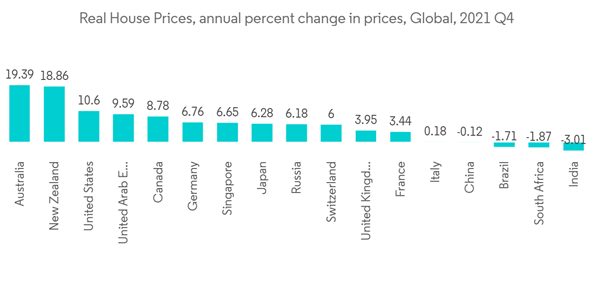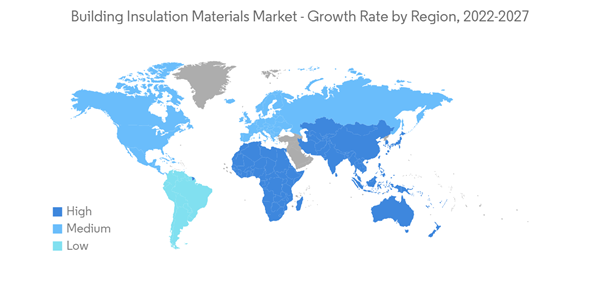The global building insulation materials market is expected to register a CAGR of less than 4% during the forecast period.
Due to the impact of COVID-19, the production facilities were halted for several months as the lockdown was implemented, and the supply chain was splintered. However, the market recovered in the 2021-22 period, owing to rising consumption from end-user industries, especially the residential sector. Over the past two years, a rise in home sales, the beginning of new projects, and the demand for dormitories and hotels have driven the market's recovery.
This product will be delivered within 2 business days.
Due to the impact of COVID-19, the production facilities were halted for several months as the lockdown was implemented, and the supply chain was splintered. However, the market recovered in the 2021-22 period, owing to rising consumption from end-user industries, especially the residential sector. Over the past two years, a rise in home sales, the beginning of new projects, and the demand for dormitories and hotels have driven the market's recovery.
Key Highlights
- The growing demand for energy efficiency, rising infrastructure, and industrialization in the Asia-Pacific region are the main factors anticipated to boost the demand for building insulation materials.
- Harmful effects caused by building insulation material on exposure to high-temperature are likely to hamper the market's growth.
- The use of organic products for insulation will likely provide new growth opportunities for the market.
- Europe dominated the building insulation materials market. Asia-Pacific is forecasted to be the fastest-growing market due to the increasing consumption of countries such as China and India.
Building Insulation Materials Market Trends
Residential Sector to Dominate the Market
- Insulation of residential buildings is gaining popularity due to its architectural and energy efficiency benefits. Promoting energy efficiency (EE) requirements for new residential buildings has been proven an effective mandatory policy instrument to slow down the increase of energy consumption in the residential building sector.
- Residential construction globally has witnessed significant growth over the past few years due to population growth, migration from rural areas to service sector clusters, and the growing trend of nuclear families.
- Decreasing land-to-population ratio and the growing trend of constructing high-rise residential buildings and townships have been driving the application of building insulation materials in the residential construction segment across the globe.
- In the recent past, the highest growth rate regarding residential construction was registered in the Asia-Pacific region, owing to the expanding housing construction markets in China and India. In Chinfacilities, the housing authorities of Hong Kong launched several measures to push start the construction of low-cost housing. The officials aim to provide 301,000 public housing units by 2030.
- The construction of skyscrapers in Canada has been increasing in recent times. Over 30 high-rise buildings are expected to be completed by 2025, and another 50 are in Toronto's proposal and planning phases.
- The Brazilian government plans to invest BRL 278 billion (~USD 52.19 billion) in popular housing and urbanization works by 2025. This am unt will allow the contracting of up to 2.5 million housing units with very reduced interest rates.
- According to the Indian Government, by 2030, more than 40% of the Indian population is expected to live in urban India (34% in 2021), likely creating a demand for 25 million additional affordable units. In Mar 2021, the Parliament passed a bill to create a USD 2.5 Billion development finance institution called National Bank for Financing Infrastructure and Development (NaBFID) to fund infrastructure projects in India.
- The abovementioned factors are likely to positively affect the demand for building insulation in the residential construction sector during the forecast period.
Europe Region to Dominate the Demand
- Germany has the largest construction industry in Europe. According to the Central Association of the German Building Industry and the Main Association of the German Building Industry, the German construction sector is anticipated to bring in sales of EUR 151 billion (~USD 160.89 billion) in 2022. The growth can be attributed to the expansion of the residential construction sector, which has shown lucrative growth in the past.
- The commercial construction sector in Germany is expected to witness significant growth prospects during the forecast period. The sales in 2022 are likely to reach EUR 53.3 billion (~USD 56.78 billion) which is likely to be supported by increased real disposable incomes, and numerous investments by the European Union and the German government.
- According to the European Investment Bank Group, the bank provided EUR 99 million (~USD 105.48 million) loan to Hemsö Fastighets AB to create more energy-efficient social infrastructure in Sweden and Finland. Nine buildings for social services will be built, including nursing homes, a medical facility, preschools, and school services.
- According to Federal Statistical Office (Destatis), in May 2021, the construction of 32,384 dwellings was permitted in Germany, an increase of 8.7 % compared to April 2021. Moreover, millions of immigrants are projected to arrive in Germany in the coming few years who may require thousands of new dwellings.
- The Global Gateway is a project planned by the European Union to develop new infrastructures. The European Commission said the European Fund for Sustainable Development will make up to EUR 135 billion (~USD 143.84 billion) available for investments in infrastructure projects between 2021 and 2027.
- As per the Office of National Statistics of the United Kingdom, the monthly construction output increased by 1.5% in volume terms in May 2022, with a record high in monthly-level terms (EUR 15,053 million) since records began in January 2010.
- According to the European Investment Bank Group, it contributed EUR 50 million (~USD 53.27 million) to the construction of one of the largest research infrastructure projects in Europe: The European Spallation Source (ESS).
- Overall, the demand for building insulation materials in Europe is expected to grow thereby benefiting the building insulation materials market.
Building Insulation Materials Market Competitor Analysis
The global building insulation materials market is fragmented, with no player occupying a significant position in the market. The major companies in the market studied (in no particular order) include Saint-Gobain, Owens Corning, Knauf Gips KG, Rockwool International A/S, and BASF SE, among others.Additional benefits of purchasing the report:
- The market estimate (ME) sheet in Excel format
- 3 months of analyst support
This product will be delivered within 2 business days.
Table of Contents
1 INTRODUCTION
4 MARKET DYNAMICS
5 MARKET SEGMENTATION (Market Size in Value)
6 COMPETITIVE LANDSCAPE
Companies Mentioned (Partial List)
A selection of companies mentioned in this report includes, but is not limited to:
- Atlas Roofing Corporation
- BASF SE
- Beijing New Building Material (Group) Co. Ltd
- DuPont
- GAF
- Huntsman International LLC
- Johns Manville
- Kingspan Group
- Knauf Gips KG
- Owens Corning (including Paroc Group)
- ROCKWOOL International A/S
- Saint-Gobain
- Synthos
Methodology

LOADING...










